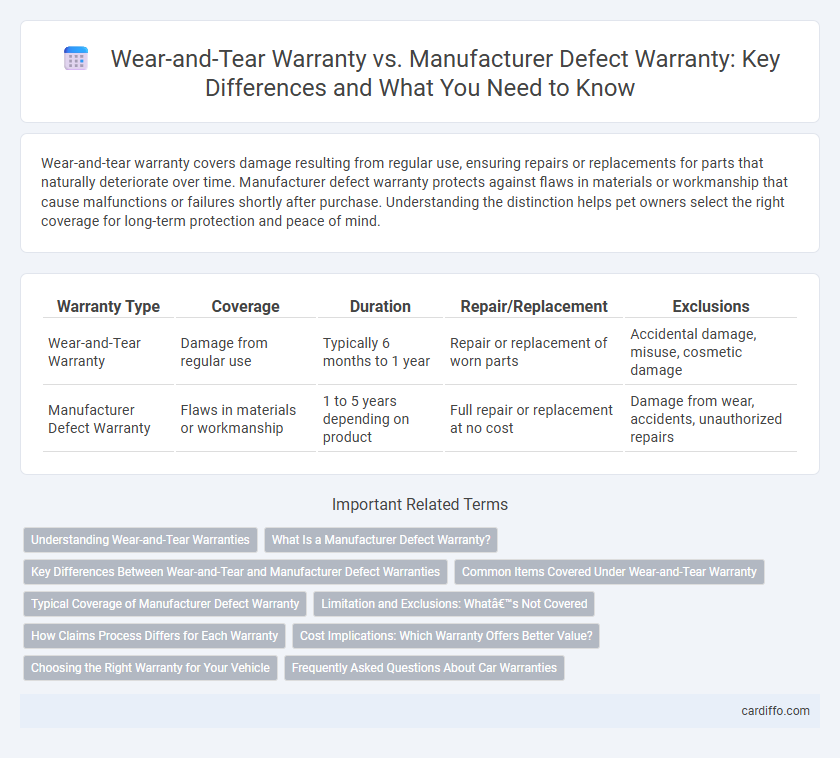Wear-and-tear warranty covers damage resulting from regular use, ensuring repairs or replacements for parts that naturally deteriorate over time. Manufacturer defect warranty protects against flaws in materials or workmanship that cause malfunctions or failures shortly after purchase. Understanding the distinction helps pet owners select the right coverage for long-term protection and peace of mind.
Table of Comparison
| Warranty Type | Coverage | Duration | Repair/Replacement | Exclusions |
|---|---|---|---|---|
| Wear-and-Tear Warranty | Damage from regular use | Typically 6 months to 1 year | Repair or replacement of worn parts | Accidental damage, misuse, cosmetic damage |
| Manufacturer Defect Warranty | Flaws in materials or workmanship | 1 to 5 years depending on product | Full repair or replacement at no cost | Damage from wear, accidents, unauthorized repairs |
Understanding Wear-and-Tear Warranties
Wear-and-tear warranties cover damage resulting from normal usage over time, such as fading, scratches, or mechanical wear, while manufacturer defect warranties address flaws caused by production errors or faulty materials. Understanding wear-and-tear warranties is crucial because they typically exclude coverage for damage caused by accidents, misuse, or neglect, focusing instead on gradual deterioration. These warranties often have shorter durations and specific conditions, emphasizing routine maintenance responsibilities to keep coverage valid.
What Is a Manufacturer Defect Warranty?
A Manufacturer Defect Warranty covers issues arising from flaws in materials or workmanship during the production process, ensuring repairs or replacements for faulty products. This warranty excludes damage caused by normal wear and tear, misuse, or accidental damage, focusing solely on defects inherent to the manufacturing stage. It typically lasts for a specific period after purchase, offering consumers protection against inherent product failures.
Key Differences Between Wear-and-Tear and Manufacturer Defect Warranties
Wear-and-tear warranties cover damage resulting from normal use and aging of a product, whereas manufacturer defect warranties protect against flaws arising from the production process or materials. Wear-and-tear warranties often have limited coverage periods and specific conditions, while manufacturer defect warranties typically offer broader protection within a defined timeframe. Understanding these distinctions is crucial for consumers to determine the scope of repairs or replacements eligible under each warranty type.
Common Items Covered Under Wear-and-Tear Warranty
Wear-and-tear warranties typically cover common items such as brake pads, tires, windshield wipers, and battery replacements that degrade with regular use over time. These warranties address parts subject to natural deterioration rather than sudden malfunctions caused by manufacturing defects. Understanding the distinction between wear-and-tear coverage and manufacturer defect warranties helps consumers anticipate repair responsibilities and manage vehicle maintenance costs effectively.
Typical Coverage of Manufacturer Defect Warranty
Manufacturer defect warranties typically cover failures resulting from flaws in materials or workmanship, ensuring repairs or replacements for faulty components during the warranty period. These warranties exclude damage caused by wear-and-tear, mishandling, or environmental factors, focusing solely on inherent product defects. Coverage often includes parts, labor, and sometimes shipping costs, providing comprehensive protection against manufacturing errors.
Limitation and Exclusions: What’s Not Covered
Wear-and-Tear Warranty excludes damages caused by normal usage, such as scratches, dents, or gradual component degradation, limiting claims to issues from everyday use. Manufacturer Defect Warranty specifically excludes damages from accidents, misuse, unauthorized repairs, or modifications, focusing coverage strictly on faults originating during the manufacturing process. Both warranties commonly limit coverage by omitting consumable parts, cosmetic damages, and damages caused by user negligence or environmental factors.
How Claims Process Differs for Each Warranty
Claims for wear-and-tear warranties typically require proof of regular maintenance and detailed documentation of gradual deterioration due to normal use, with inspections focusing on expected usage timelines. Manufacturer defect warranty claims demand evidence of a flaw in materials or workmanship present from the time of purchase, often involving diagnostic tests and manufacturer authorization before repair or replacement. Processing times for wear-and-tear claims tend to be longer due to the need for condition assessments, while defect claims are usually expedited through direct manufacturer involvement.
Cost Implications: Which Warranty Offers Better Value?
Wear-and-tear warranty typically covers damage resulting from regular use, often leading to higher premiums due to broader coverage, while manufacturer defect warranty focuses solely on faults in materials or workmanship, usually offering lower costs but limited protection. Evaluating cost implications, wear-and-tear warranties may provide better long-term value by mitigating unexpected repair expenses, especially for products prone to frequent use and degradation. Manufacturer defect warranties are cost-effective for buyers prioritizing protection against manufacturing faults but may result in higher out-of-pocket costs for other damages.
Choosing the Right Warranty for Your Vehicle
Selecting the right warranty for your vehicle involves understanding the differences between wear-and-tear warranties and manufacturer defect warranties. Wear-and-tear warranties cover parts that naturally degrade over time, such as brake pads and tires, while manufacturer defect warranties protect against faults in materials or workmanship. Opt for a warranty that aligns with your driving habits and vehicle usage to maximize coverage and avoid unexpected repair costs.
Frequently Asked Questions About Car Warranties
Wear-and-tear warranties typically cover routine maintenance issues and components expected to degrade over time, while manufacturer defect warranties address faults in materials or workmanship present at the time of purchase. Frequently asked questions about car warranties often include inquiries about the duration of coverage, what specific repairs are included, and how to file a claim for either type. Understanding the distinction is essential for consumers to avoid unexpected repair costs and ensure proper warranty utilization.
Wear-and-Tear Warranty vs Manufacturer Defect Warranty Infographic

 cardiffo.com
cardiffo.com